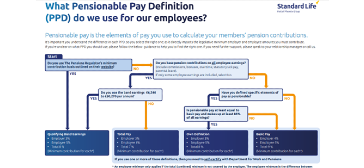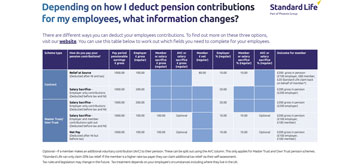What has changed?
The Pensions Regulator (TPR) requires pension providers and employers to monitor the contributions paid into workplace pension schemes.
For employers, it’s their responsibility to make sure the contribution amounts are accurate and in line with any contractual agreements with their employees.
You can find out more about monitoring contributions on the General code of practice sections on TPR`s website.
What do employers need to do?
For Standard Life to support employers, we need them to provide us with additional information in their payroll files. This will help us to fulfill the legal duties as set out within TPR's code of practice. It's required for all workplace pension scheme members, for every pay period.
id
See our table below for details on the information we need and in which format.
If you need further help, have a look at these two PDF's we've created to help with key field decisions:
id
| Data item name | Mandatory, conditional, or optional | Maximum number of characters | Data format | Explanatory notes |
|---|---|---|---|---|
| Pay Period Pensionable Earnings | Mandatory | 15 | 1000.00 | This is the gross earnings for that pay period you use to calculate their pension contribution. Only enter numbers and decimal point. |
| Member % | Conditional | 5 | 3.00 | If an employee payment is being made, please enter the %. Only enter numbers and decimal point. |
| Employer % | Mandatory | 5 | 5.00 | If an employer payment is being made, please enter the %. Only enter numbers and decimal point. |
| Regular (employer) | Mandatory | 15 | 150.00 | If an employer payment is required, enter the gross amount. Don’t enter commas or £. |
| Regular (member) | Conditional | 15 | 100.00 | If an employee payment is required, enter the amount. Net for Contract schemes/ Gross for Trust Based Pension or Master Trust schemes. Don’t enter commas or £. |
| Qualifying Workplace Pension Scheme (QWPS) only | ||||
| Pensionable Pay Definition(s) | Mandatory | 3 | QBE |
If your pension scheme is a QWPS, we need to know the pay definition you're using for each member. You can find more details on our Pensionable Pay Definition(s) page. |
id
For more information on what is needed in the data file, see our Group Pension Zone (GPZ) data exchange guides. You can download the new data field templates directly from GPZ.
| Product | Data exchange guide |
|---|---|
| Master Trust (MT) and Trust Based Pensions (TBP) | MT and TBP data exchange guide |
| Group Flexible Retirement Plan (GFRP) | GFRP data exchange guide |
| Good to go (GTG) | GTG data exchange guide |
| Group Personal Pension (GPP) | GPP data exchange guide |
| Group Personal Pension Flex (GPPFlex) | GPPFlex data exchange guide |
| Group Stakeholder Pension Plan (GSPP) | GSPP data exchange guide |
| Contract In Money Purchase (CIMP) | CIMP data exchange guide |
id
What will Standard Life do with this information?
We’ll review the information submitted and raise any queries with employers directly. Employers will then have 90 days to resolve these queries in their payroll.
If these issues are unable to be resolved within the timeframe, then Standard Life – like all pension providers – have a duty to report the employer to TPR. From then on, TPR can engage with the employer with the aim of resolving these issues.
id
When do employers need to start providing extra information?
All payroll files submitted from now on need to include the additional data that we've outlined in the table above.

